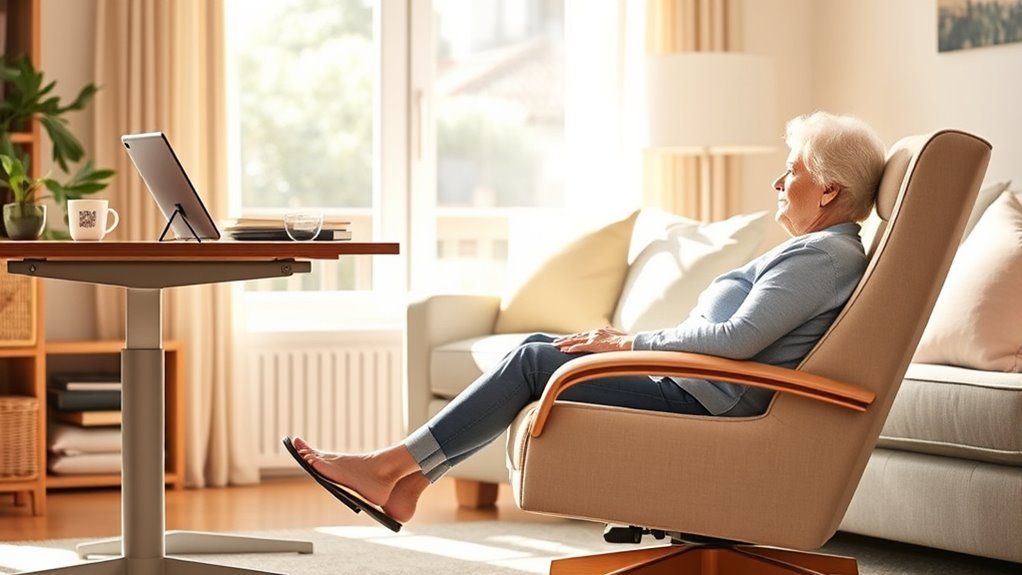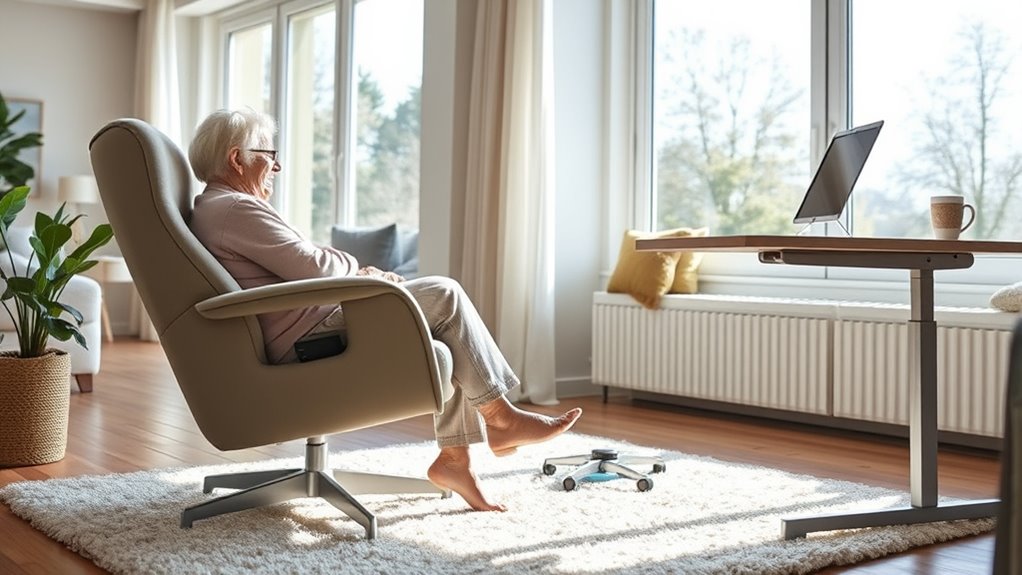When choosing ergonomic furniture for seniors, prioritize safety, comfort, and support. Look for features like adjustable height chairs and beds, built-in handles, and stable bases to reduce fall risks and ease mobility. Incorporate assistive technology and use soft, bright lighting to make spaces more accessible. Keep pathways clear and choose non-slip rugs for added safety. To create an environment that promotes independence and dignity, it’s important to select the right pieces—discover more tips below.
Key Takeaways
- Prioritize adjustable furniture to accommodate changing mobility and comfort needs.
- Select pieces with stable, wide bases and slip-resistant features to prevent falls.
- Incorporate built-in assistive technology, like lift mechanisms and easy-to-reach controls.
- Ensure furniture height promotes safe sitting and standing without excessive bending.
- Personalize choices based on individual health, preferences, and safety requirements.

Choosing ergonomic furniture for seniors is essential for promoting comfort, safety, and independence. When selecting pieces for a senior’s living space, you’re not just focusing on style—you’re prioritizing functionality and support. Assistive technology can be integrated into everyday furniture to enhance mobility and ease of use. For example, chairs with built-in lift mechanisms or adjustable features can help seniors stand up and sit down without strain. These innovations, combined with thoughtful interior design tips, create a space that’s both welcoming and practical. Proper furniture isn’t just about aesthetics; it’s about making daily routines safer and more manageable.
Incorporating assistive technology into furniture design makes a significant difference. Look for chairs and sofas with high-density foam cushions and firm but comfortable support, which help maintain proper posture and reduce pain. Consider furniture with built-in handles or armrests that provide stability when sitting or rising. Adjustable beds with remote controls are another excellent addition, allowing seniors to modify their sleeping position easily. When choosing ergonomic furniture, keep in mind that the right features can prevent falls and minimize the risk of injuries caused by slipping or improper support. These tools empower seniors to maintain their independence longer, giving them confidence in their daily activities.
Interior design tips play a crucial role in creating a senior-friendly environment. Keep furniture at accessible heights—tables, desks, and chairs should be easy to reach without bending or stretching excessively. Opt for wide, stable bases to prevent tipping and ensure stability. Lighting should be bright but soft, avoiding glare that can cause discomfort or disorientation. Clear pathways free of clutter are vital, so choose furniture that doesn’t obstruct movement. Adding rugs with non-slip backing or using slip-resistant mats can further prevent falls. When arranging furniture, consider the natural flow of movement, making it intuitive and effortless for seniors to navigate their space. These small adjustments can considerably enhance safety and comfort.
Lastly, selecting ergonomic furniture with the user’s specific needs in mind is key. Think about their mobility levels, any existing health issues, and personal preferences. Customizable options, such as adjustable height chairs or beds, ensure the furniture adapts to changing needs over time. When you combine assistive technology with practical interior design tips, you create a living space that promotes independence and dignity. Your goal is to foster a safe environment where seniors feel comfortable, supported, and empowered to live life to the fullest.
Frequently Asked Questions
How Can Ergonomic Furniture Prevent Falls Among Seniors?
Ergonomic furniture helps prevent falls among seniors by providing better support and stability, which considerably reduces fall risk. You’ll notice improved fall prevention and risk reduction because features like sturdy armrests, adjustable heights, and non-slip surfaces make it easier to sit, stand, and move safely. By choosing ergonomic options, you create a safer environment, helping seniors maintain independence and confidence while minimizing the chances of accidental falls.
What Materials Are Best for Senior-Friendly Ergonomic Furniture?
You should choose materials that combine durability with aesthetic appeal, like high-quality wood or sturdy metal with soft, easy-to-clean upholstery. These materials stand up to daily use and provide stability, reducing fall risks. Their attractive appearance adds comfort and warmth to a space, making it inviting. By selecting such balanced materials, you guarantee your ergonomic furniture supports safety, longevity, and visual harmony in a senior-friendly environment.
How Does Ergonomic Furniture Support Seniors With Arthritis?
Ergonomic furniture supports seniors with arthritis by providing targeted arthritis relief and superior joint support. You’ll notice less pain and strain because the design encourages proper posture, reduces pressure on painful joints, and offers cushioned, adjustable features. This tailored support makes daily activities easier, helping you stay active and comfortable. By choosing ergonomic furniture, you actively manage arthritis symptoms and improve your overall well-being with improved joint support.
Are There Adjustable Features Suitable for Various Mobility Levels?
Imagine a chair that adapts like a reliable friend, fitting your unique needs. Yes, adjustable height features let you find the perfect sitting level, while customizable armrests support different mobility levels with ease. These adjustable features symbolize independence, allowing seniors to personalize comfort without hassle. With these options, you gain confidence and freedom, making daily activities smoother and safer, no matter your mobility stage.
What Is the Average Lifespan of Ergonomic Furniture for Seniors?
You can expect ergonomic furniture for seniors to last around 7 to 15 years, depending on durability testing and usage. Well-designed pieces with quality materials often withstand daily wear and tear longer, maintaining their comfort and support. Pay attention to design aesthetics too, as attractive furniture encourages regular use. Proper maintenance and choosing reputable brands can extend the lifespan, ensuring your investment remains functional and stylish for many years.
Conclusion
Think of choosing ergonomic furniture for seniors as planting a sturdy tree. With the right care and support, it grows strong and resilient, offering comfort and stability. By selecting pieces that prioritize their needs, you’re nurturing their well-being, allowing them to flourish with ease. Just like a tree provides shelter and strength, the right furniture becomes a foundation for their independence and comfort, ensuring they thrive in every moment.









